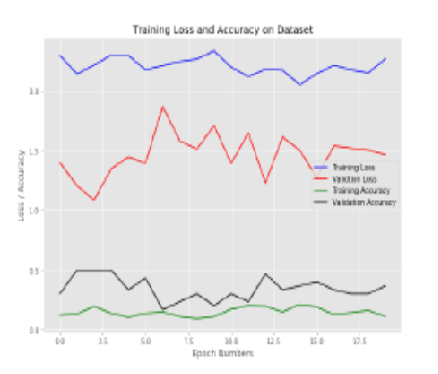


Indian Journal of Science and Technology
Year: 2023, Volume: 16, Issue: 5, Pages: 318-330
Original Article
T R Arunkumar1*, H S Jayanna2
1Research Scholar, Department of Computer Science & Engineering, Siddaganga Institute of Technology, Tumkur, India
2Professor and Head, Department of Information Science, Siddaganga Institute of Technology, Tumkur, India
*Corresponding Author
Email: [email protected]
Received Date:23 August 2022, Accepted Date:10 December 2022, Published Date:04 February 2023
Objectives: To design and develop a computer-aided tool for the estimation of the severity of psoriasis-affected skin areas using depth-wise convolution neural networks. Methods: The experiment consists of 5951 input images which are divided into a training set, validation set, and testing set. The training set consists of 2282 mild images, 646 moderately affected images, and 323 severely affected psoriasis images. The validation set consists of 600 mild, moderate, and severely affected images in each category. The testing set consists of 200 mild, moderate, and severely affected images in each category. The reconstructed MobileNet machine learning model is used in the estimation of severity. The reason for using the reconstructed MobileNet machine learning model is the less turnaround time required in the estimation of severity and the use of depth-wise convolution layers around which the model is built, which can be implemented in low-power, low-memory handheld devices. At the initial stages, pre-trained weights of ImageNet are used and at a later stage of the experiment, the network learns from our input data set. Findings: The experimental results proved to be significant and accurate when verified with the dermatologists. The fully trained network on the input data set is found to predict the severity around 90% which is counter-verified by the dermatologists. At the beginning of the experiments, when the neural network was run on the data set with the weights from ImageNet, the estimate of the disorder was not convincing. As the neural network was trained and weights were recalculated based on our collected data set, the results got improved. Even though MobileNet machine learning model was used, the average turnaround time for 20 epochs was about 27 minutes, which is a significant part of the experiment in developing the tool. An average F1 score of .94 is achieved when all the layers of the network are trained. Novelty: The novelty of the work lies in the prediction of the types of the severity psoriasis disorder accurately with less turnaround time with an accuracy of 90% where the results are cross verified by dermatologists and the tool canbe implemented on low-powered, low-processing hand-held devices.
Keywords: Psoriasis; Depthwise convolution neural network; Machine Learning; Keras; Skin Texture
© 2023 Arunkumar & Jayanna. This is an open-access article distributed under the terms of the Creative Commons Attribution License, which permits unrestricted use, distribution, and reproduction in any medium, provided the original author and source are credited. Published By Indian Society for Education and Environment (iSee)
Subscribe now for latest articles and news.